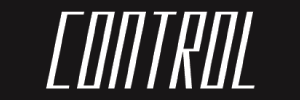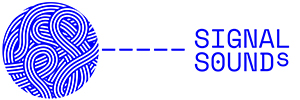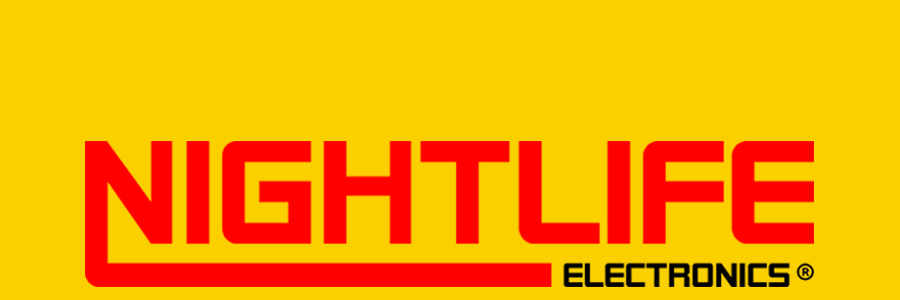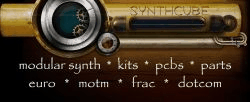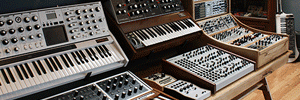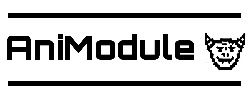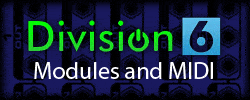
Showing posts sorted by relevance for query KORG 700s. Sort by date Show all posts
Showing posts sorted by relevance for query KORG 700s. Sort by date Show all posts
Monday, January 17, 2011
MINI KORG KORG 700S - HQ SOUND DEMO vintage synthesizer 1974 miniKORG
YouTube via AnalogAudio1 | January 17, 2011 |
Updated title: MINIKORG KORG 700S Analog Synthesizer 1974 | HQ DEMO | Mini Korg
"The monophonic Mini-Korg 700S was an expanded version of Korg's first synthesizer, the Mini-Korg 700. It has 2 VCOs, 1 "traveler" filter (12 dB, highpass/lowpass) 1 envelope generator and 1 LFO. It also has noise generator, ring modulator and the LFO can be switched to the filters.
The Korg 700s is a serious synthesizer with a lot of character. It has a fantastic sound, which can be only compared with the first generation Korgs (Korg 770, 800 DV).
It was used by Vangelis in the seventies. Also Kitaro's all time favourite synthesizer.
I played the Minikorg with Lexicon MPX 500 reverb and Roland DEP-5 delay."
Thursday, July 16, 2020
KORG MINIKORG 700S Analog Synthesizer 1974 | HD DEMO |
AnalogAudio1
"I played the Minikorg 700S along with a Lexicon MPX 500 (reverb) and a Korg SDD-3000 (delay effects).
The monophonic Mini-Korg 700S was an expanded version of Korg's first synthesizer, the Mini-Korg 700. It has that awesome "traveler" filter (12 dB highpass and lowpass), 2 VCOs (wavevorm of the VCO 2 is always sawtooth), 1 envelope generator and 1 LFO (sine wave only). It also has noise generator, ring modulator modes and the LFO can also be switched to the filters. It has REPEAT mode, which repeats a note to get a sequencer-like feeling.
The Korg 700s is a serious analog synthesizer with a lot of character. It has a fantastic sound, which can be only compared with the first generation Korgs (Korg 770, 800 DV). The parameters use unconventional terminology (singing level, expand, bright, and so on). The 700s has a very nice tone and it's easy to use. A pleasure to play and to hear.
The MiniKORG 700s was used by Vangelis, Kitaro, Human League, Daniel Miller and others."
Wednesday, September 18, 2013
The Korg Volca Series Video Overviews by AutomaticGainsay
The Korg Volca Series: Korg Volca Beats- Sounds
Published on Sep 18, 2013 AutomaticGainsay·167 videos
"Here is a demonstration of the sound and functionality of the new analog/PCM drum machine "Volca Beats" from Korg."
KORG Volcas on eBay
Published on Sep 18, 2013 AutomaticGainsay·167 videos
"Here is a demonstration of the sound and functionality of the new analog/PCM drum machine "Volca Beats" from Korg."
KORG Volcas on eBay
Tuesday, March 15, 2011
RIP Mr. Tsutomu Katoh - Founder of KORG
 A letter via Seiki Kato, President of KORG Inc.
A letter via Seiki Kato, President of KORG Inc."Dear Sirs and Madams,
I would like to inform you that our founder and chairman Mr. Tsutomu Katoh passed away early this morning (March 15, 2011) after a long fight with cancer.
Since he founded Korg Inc. in 1963, Mr. Katoh has led our company with great talent, vision and leadership. He was loved and respected by all the employees, all Korg family members and made a huge contribution to the lives of countless musicians around the world.
Plans for a memorial service will follow very soon.
I would appreciate your prayers for him and hope he can rest peacefully now.
Sincerely,
Seiki Kato
President
Korg Inc."
Tsutomu Katoh and the History of Korg
Another hero lost; one of the first to define the world of synthesis as we know it. The gifts he gave us will always be remembered and will inspire new synth enthusiasts and musicians for decades to come. Tsutomu Katoh-san, you will be missed. Thank you for everything you gave us.
Via Wikipedia: "Founded in 1962 in Japan by Tsutomu Kato and Tadashi Osanai, Korg was originally known as Keio Gijutsu Kenkyujo Ltd." and later "Keio Electronic Laboratories (京王技術研究所?) because its fledgling offices were located near the Keio train line in Tokyo and Keio can be formed by combining the first letters of Kato and Osanai. Before founding the company, Kato ran a nightclub. Osanai, a Tokyo University graduate and noted accordionist, regularly performed at Kato's club accompanied by a Wurlitzer Sideman rhythm machine. Unsatisfied with the rhythm machine, Osanai convinced Kato to finance his efforts to build a better one..." And indeed they did.
This sad news in via Amos of Moog Music and Michelle Moog-Koussa of the Bob Moog Foundation.
Update: some condolences and pics on the KORG Forum here.
Some video of the legacy of instruments he brought us with a rare interview in Part 1 (previously posted):
'The Vintage Synth - Volume 3: Korg' 1-11
YouTube via baward — November 24, 2009 —
"Rare, Japanese-language video from some time in the 1990's, taking the viewer on an odyssey through Korg's many instruments, from Korg's synthesizer museum at its Tokyo headquarters.
Two other videos were produced in this series, 'The Vintage Synth - Volume 1: Moog and 'The Vintage Synth - Volume 2: Roland'"
Part 1: "This clip features an interview with Korg's co-founder Tsutomu Kato and footage of the rare DA-20 Doncamatic drum machine (1963) and an early appearance of Korg's famous 'Traveler' filter control - on an organ! (late 1960's.) More to follow."
Part 2: "This clip features the Korgue organ from 1968, as well as Korg's first synthesizer, the Mini Korg 700 from 1973 (here shown in its expanded 2 oscillator version, 1974's Mini Korg 700S.)"
Part 3: "This clip features the Synthesizer 800DV (1974), Synthesizer 770 (1975), and the PE-1000 (1976)."
Part 4: "This clip features the polyphonic, patchable, part-modular and extremely rare PS-3300 (1978)."
Part 5: "This clip features part one of the MS series (1978-79), focussing on the wall-mounted 'education' MS-20 as well as some other early analogue products."
Part 6: "This clip features the MS-20 and MS-50 synthesizers, VC-10 vocoder and SQ-10 analog sequencer (1978-79) in more detail."
Part 7: "This clip features the Delta strings synthesizer, Trident polyphonic synthesizer, and BX-3 analogue organ (1980-81)."
Part 8: "This clip features the first part of an in-depth look at the Polysix synthesizer from 1981."
Part 9: "This clip features the second part of the Polysix synthesizer feature and the one on the Mono/Poly."
Part 10: "This clip features the Poly-800II and the DW-8000 (1985)"
Part 11: "Computer-control of MS instruments (or is it the 05R module?) with 700S, original Korg Wavedrum, as well series conclusion."
Monday, April 15, 2013
Mystery Synth - Korg 700s/770 Prototype?
Published on Apr 15, 2013
"I found this "mystery synth" at a garage sale this weekend. It appears very similar to a Korg 700s, but upon closer examination there are clear differences. The second oscillator has it's own waveform and pitch selector, for example. And the style of sliders and controls are certainly different than those found on a 700s.
If you know anything about this instrument, please let me know!
At any rate it's a great sounding synth!"
This one in via via Dan Goldstein who found the synth. Talk about an amazing find.
Click here for a pic of the inside of a Mini-KORG 700. Update: also click here for one more. Note two of the boards appear to match but this mystery synth has one more. I couldn't find any of the inside of a 770 to compare. If you search for KORG 770 or KORG 700s you will see the controls are similar but different. With that we are left with two possibilities, this is either a very nicely done DIY synth composed of vintage KORG parts or a KORG prototype that fell somewhere within the 700 series.
And details also posted on gearslutz: "Here's everything I know about it:
I found this instrument on CraigsList, posted at a garage sale here in Las Vegas. The seller said that he'd purchased it on eBay not knowing what it was, and that he believed it was "built by a guy that worked at Ibanez." That was all the provenance that he was able to provide. The instrument was clearly so bizarre that I had to take it home and find out more about it. It does work, mostly, and it certainly has a unique sound despite it's incredibly strange architecture, which I'll describe below.
I opened it up, eagerly hoping for clues about its origins, but what I found deepened the mystery further. As you can see in the photos below, the circuity of this synthesizer is totally discreet. There are some metal can-style Op Amps, namely 741HC and MN131A, which would seem to date this in the early 70s. There are no markings of any sort on the circuit boards, just hand-labeled numbers by the patch points on the circuit boards. I can't find any sort of name anywhere, though the words "Made In Japan" are on the 1/4" output panel.
The architecture of this instrument is incredibly bizarre. It features two standard oscillators. Oscillator one has triangle, square, and sawtooth waveforms, plus a "Chorus 1" and "Chorus 2" setting that seem to be chorused sawtooth waves. Oscillator two features triangle, square, sawtooth, a thinner square wave, and reverse sawtooth. Then there's a third sort of oscillator, which is switchable between noise and what I think is some sort of ring-modulator that operates on Oscillator One. There's a global tuning knob but no fine-tune knobs for the oscillators.
Things get weird after that. There's an attack-release envelope for the VCA, and that's the only envelope you get. There's a resonant low-pass filter and a resonant high-pass filter, but no resonance knob, so you're stuck with a single cutoff control for each filter. The low and high cutoff filters are sort of "ganged" together so that you can't move the Lowpass cutoff above the Highpass cutoff - they move together once they meet, if that makes sense. There's an LFO that seems to be fixed at a triangle wave, and it can be routed to frequency or filter or both, and there's some sort of vibrato delay switch that doesn't seem to do anything. There's also a Repeat switch and speed control that will cause the envelope to retrigger, which is pretty cool. There are some other bizarre controls too, including a "Bright" switch that makes the sound brighter, an "Expand" switch that doesn't really do much of anything, and a "Bender" switch that causes notes to quickly bend up to the pressed key (I remember a similar feature on the Roland VP330, for example).
There's a 3-position sustain switch that goes from "Short" to "Long" and determines if the envelope continues after you've released a key. It works fine, but as soon as you release a key the frequency of the note played drops to some lower, random value. Perhaps the sample-and-hold is not working right.
The cabinet and design is clearly Minimoog inspired, but it's not a Minimoog case. My first thought was that this was a home-made synth of some kind but I'm very doubtful after spending time with it. The silkscreening is very professionally done, the cabinet is all custom-made with interesting angles. There's even a sort of thumb screw on the bottom that lets you lock down the folding-up synth portion of the instrument for transport. Everything about the instrument seems to suggest it was professionally made. The only outputs are a Low and High audio output. There are no inputs at all, no bend wheel or mod wheel, though there's clearly space for such a thing. The lack of basic features (i.e. sustain & release envelope stages, fine tune, resonance amount, etc.) and the addition of unusual features (repeat, bender, etc.) make for one odd combination. And the fact that I can't find any label anywhere makes this a serious synthesizer mystery.
I've owned an awful lot of analog synthesizers and have read decades worth of magazines and web sites, and I've never seen anything like this. Does anyone here have any insight at all into what this might be? Perhaps it's a kit synth from the 70s, like a PAIA design of some kind? Perhaps this was a prototype for a product that never got built? The components date it to the early 70s, so perhaps some company was attempting to challenge the Minimoog and decided against it? If anyone has any information at all on what this could be, I'd sure appreciate it! I'm happy to answer any questions about this synth."
Monday, December 16, 2019
1970s Univox Korg K-2 Mini-Korg 700S Vintage Monophonic Analog Synthesizer SN 1318 w/ Case
Note: Auction links are affiliate links for which the site may be compensated.
via this auction, also on Reverb
 "1970s Univox K-2 Korg Mini-Korg 700S monophonic analog synthesizer in excellent condition and in perfect working order. Made in Japan by Korg, the K-2 was distributed to American markets under the Univox brand. An early, classic, straightforward monophonic all-analog synthesizer, the K-2 can most notably be heard in action on the Cars’ recordings.
"1970s Univox K-2 Korg Mini-Korg 700S monophonic analog synthesizer in excellent condition and in perfect working order. Made in Japan by Korg, the K-2 was distributed to American markets under the Univox brand. An early, classic, straightforward monophonic all-analog synthesizer, the K-2 can most notably be heard in action on the Cars’ recordings.
Korg’s very first synthesizer was the Mini-Korg 700 and offered a single oscillator, while the improved 700S provides a pair. Sawtooth, triangle and square waves define the textural cut, while both low and high-pass filters can be used to tame the tooth. The intuitive layout is comprised of a smattering of substantial-feeling knobs and sliders, with controls labeled Bender, Traveler and Expand for the auto-bend, filter and envelope, respectively. Thick, textural tones emanate from this analog inspiration with ease.
Cosmetically, this Univox K-2 is very clean with all of the original knobs and screenprinting intact. The hardwood end caps show some minor edge wear and scuffing, and this synth comes with its original case."
via this auction, also on Reverb
 "1970s Univox K-2 Korg Mini-Korg 700S monophonic analog synthesizer in excellent condition and in perfect working order. Made in Japan by Korg, the K-2 was distributed to American markets under the Univox brand. An early, classic, straightforward monophonic all-analog synthesizer, the K-2 can most notably be heard in action on the Cars’ recordings.
"1970s Univox K-2 Korg Mini-Korg 700S monophonic analog synthesizer in excellent condition and in perfect working order. Made in Japan by Korg, the K-2 was distributed to American markets under the Univox brand. An early, classic, straightforward monophonic all-analog synthesizer, the K-2 can most notably be heard in action on the Cars’ recordings. Korg’s very first synthesizer was the Mini-Korg 700 and offered a single oscillator, while the improved 700S provides a pair. Sawtooth, triangle and square waves define the textural cut, while both low and high-pass filters can be used to tame the tooth. The intuitive layout is comprised of a smattering of substantial-feeling knobs and sliders, with controls labeled Bender, Traveler and Expand for the auto-bend, filter and envelope, respectively. Thick, textural tones emanate from this analog inspiration with ease.
Cosmetically, this Univox K-2 is very clean with all of the original knobs and screenprinting intact. The hardwood end caps show some minor edge wear and scuffing, and this synth comes with its original case."
Monday, August 09, 2021
miniKORG 700S VST | HQ Presets Preview | Update 1.0.1
video upload by Simon Le Grec
"KORG Collection 3 introduces three new software recreations to the world: KORG's first mass-produced analog synthesizer, the miniKORG 700S, the MOSS Tone Generator-powered Prophecy, and the Triton Extreme, the vacuum tube-equipped high point of the Triton series. KORG Collection 3 has now expanded to be a thrilling collection of iconic sounds from the '70s, '80s, '90s, and '00s.
The original miniKORG 700S was a 2VCO, 2VCF, 1EG, 1LFO monophonic synthesizer. Because synthesizers were not as common as they are today, its circuitry was unique. For example, when developing the triangle wave oscillator, the engineers aimed to create a circuit that produced a beautifully musical sound rather than a scientifically accurate one.
In addition to the oscillator circuit, the low and high pass filters were combined into a single, unique part called the Traveler Controller, which was a distinctive feature of KORG’s early synthesizers.
Instead of a more traditional ADSR style envelope, the miniKORG700s allows the user to control the shape of the sound with two sliders; one that controls attack time and decay time, and one that controls sustain level and release time. These quirks and more have all been faithfully reproduced in the software version.
The miniKORG 700S for Mac and Windows not only faithfully recreates the functionality and sounds of the original miniKORG 700S’s various parameters, but also includes many additional capabilities that bring the synthesizer into the modern era, and make it suitable for any music production environment.
There are more than 150 preset programs included with the miniKORG700s, split into 13 different categories like leads and basses. Ranging from sounds overflowing with vintage flavor to complex timbres you wouldn’t think could be created with such a simple interface, there is a huge variety of sounds available to choose from. Of course, you can add your own sounds to the library as well.
The graphical user interface (GUI) of the miniKORG 700S for Mac and Windows has realistically recreated the appearance of the original miniKORG 700S in both 2D and 3D. You can freely switch between the two, opting for the experience of using a hardware synthesizer or the convenience of a software synthesizer. There are also three screen sizes you can easily switch between to fit your environment without affecting the image quality for both the standalone and plugin versions.
In addition to the GUI, the various plugin parameters can also be controlled using MIDI CC, allowing you flexible, real-time control via a MIDI controller or Digital Audio Workstation
Chapter:
00:00 Lead
02:33 Bass
06:00 Synth Hard
08:00 Synth Soft
09:38 Motion
10:46 Pad/Strings
14:19 Bell
14:48 Seq
19:47 Chord
20:39 Pluck
22:14 Brass
22:55 Complex
23:14 Drum"
Thursday, July 29, 2021
KORG Collection 3 - A Synthesizer Collection for the ages Including miniKORG 700S, Prophecy & Triton Extreme
video upload by Korg
"The KORG Collection 3 introduces three new software recreations to the world: KORG's first mass-produced analog synthesizer, the miniKORG 700S, the MOSS Tone Generator-powered Prophecy, and the Triton Extreme, the vacuum tube-equipped high point of the Triton series. KORG Collection 3 has now expanded to be a thrilling collection of iconic sounds from the '70s, '80s, '90s, and '00s."
"This collection precisely models the circuitry of historic analog synthesizers, fully emulating the depth and complexity of the miniKORG 700S, (KORG's first mass-produced analog synthesizer), the thick, persistent sound and flexible patching of the MS-20, the built-in effects of the six-note polyphonic Polysix, the thick, 4VCO monophony and unique polyphony of the Mono/Poly, and ARP's signature ARP Odyssey.
A vast array of digital synthesizers also await your command, including the M1, the iconic multi-functional workstation that revolutionized the music industry, the TRITON, a pillar of 2000s sound, the TRITON Extreme, the vacuum tube powered peak of the TRITON line, the WAVESTATION, which synthesizes and combines multiple waveforms for smooth tone changes and the Prophecy, a physical modeling synthesizer developed to explore brand new sonic worlds.
The KORG Collection is the embodiment of KORG's history; the ultimate showcase of the legendary sounds used on countless songs throughout the '70s, '80s, '90s, and '00s."
https://www.korg.com/us/products/software/korg_collection/
Tuesday, March 02, 2010
The Cure on Echo Des Bananas - Cold
YouTube via silong1976.
"1982-04-11 Best performance of this song I have ever seen"
I never realized the synths in this one reminded me a bit of Jean-Michel Jarre's Rendez-Vous. Some synth spotting: KORG Maxikorg 800DV, ?. Anyone recognize the bass pedals? They don't quite look like Moog Taurus pedals. What's under the Maxikorg. A bit OT, but does anyone else think the dude from the Twilight films looks like a young Robert Smith? I haven't seen them yet.
Update: some notes on the synths via Wid on the AH list:
"So here are the 3 main synths Matthieu Hartley used by 1980 :
- Korg Mini 700S.
- Roland SH-2.
- Roland RS-09 aka String Organ (late version with multicolored switches).
That's basically the sounds for "17 Seconds" : the Mini Korg was used to play the bass lines, the Roland SH-2 the higher register. Check out the video clip of "Play for Today". On stage, Hartley played the Mini 700S invariably, but switched between the 2 Rolands.
By then, Hartley was plugged in a Roland JC-120 amp. The SH-2 was dropped when Hartley left.
The RS-09 and Mini 700S were still used for "Faith" in 1981. Robert kept the RS-09 but added a Korg Maxi 800 DV to the rig. The intro of "Holy hour" was played with a RS-09, for example. "All cats are grey" and "The funeral party" were played with both RS-09 and Maxi 800 DV. The Korg Mini 700S was played by Simon Gallup on stage (for instance, on the intro of "A forest" and on "At night"). But this synth was not used after 1981, as far as I know.
Smith began adding some bass pedal synth too, by 1981 : in studio, some pictures clearly show a Moog Taurus. On stage their preference went to a far cheaper Eko K320 (played until 1982, for example on "Cold" by Simon Gallup).
The RS-09 was still used in 1982 : the synth heard on "One 100 years", played on stage by Lol Tolhurst. The Maxi 800 DV too (on "Cold" for the bass line, added to a - well I think, for this one I'm not 100 % sure, sorry - Korg Trident).
That's it for early early Cure synths. I really do not know if any of these synths are available on softwares such as Reason.
Hope the answer helps. ;-)
Wid."
Thursday, November 05, 2009
GForce Software Vintage Synth Trump Cards
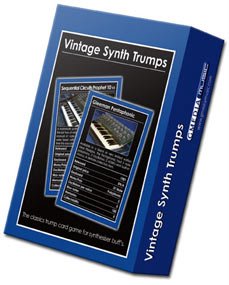
I actually posted about these way back in 2005. Mark spotted them on the GForce site and sent the link in. I thought I'd put a new post up and capture the list of synths and description for the archives. BTW, also check out this post for some Roland info cards.
"Vintage Synth Trumps
This is Vintage Synth Trumps, a deadly serious card game for vintage synth enthusiasts featuring 52 classic instruments. Test your knowledge and settle those arguments once and for all with the synth-spotter's equivalent of arm-wrestling.
Can you use your skill and judgment to win the whole pack from your opponents and become the undisputed champion of vintage synth wisdom?
Playing is easy. Simply divide the cards between the number of players before taking it in turns to read aloud a statistic from your card.
For example, "Korg PS3300 - Collectability = 5 out of 5". Everyone then compares the card on the top of their hand and the highest scoring instrument in that category wins that round. The person who gains all the cards wins.
So next time your kids pester you for a card game, extract revenge with Vintage Synth Trumps (not available from any good department stores near you).
The perfect kitsch gift for trade shows, long flights, forum banter, pub quizzes, train journeys and all round anorak type showing-off.
Buy your pack of Vintage Synth Trumps for only £7.95 (price includes first class postage, other methods available)
Friday, September 28, 2007
Korg Maxi-Korg K3 (800DV) Vintage Synthesizer 1975
"This is a unique vintage 1975 Korg Maxi-Korg synthesizer - serial number 0594! This synth is also known as the Korg 800DV and Univox K3 but was sold in the US under the name Maxi-Korg K3. The power of the Maxi-Korg lay in the way it could create and play sounds. In essence, it was two Korg 700S synths in a single box, so you could treat it as two distinct synths, creating two different sounds, and then playing them independently. Some other mid-'70s synths allowed you to play two notes, but these used the same patch parameters for both. Only the Maxi-Korg could produce two sounds that you could play as a composite, or as two independent synths. Yet this was only half the story, because the 800DV allowed you to allocate the voices in a huge variety of ways. This made it possible to program more realistic, more expressive, or more off-the-wall sounds than was possible on other monosynths. The Maxi-Korg was, and remains, one of the most impressive, flexible and articulate synths ever built."
Wednesday, June 02, 2010
'The Vintage Synth - Volume 3: Korg' 1-11
YouTube via baward — November 24, 2009 —
"Rare, Japanese-language video from some time in the 1990's, taking the viewer on an odyssey through Korg's many instruments, from Korg's synthesizer museum at its Tokyo headquarters.
Two other videos were produced in this series, 'The Vintage Synth - Volume 1: Moog and 'The Vintage Synth - Volume 2: Roland'"
Part 1: "This clip features an interview with Korg's co-founder Tsutomu Kato and footage of the rare DA-20 Doncamatic drum machine (1963) and an early appearance of Korg's famous 'Traveler' filter control - on an organ! (late 1960's.) More to follow."
Part 2: "This clip features the Korgue organ from 1968, as well as Korg's first synthesizer, the Mini Korg 700 from 1973 (here shown in its expanded 2 oscillator version, 1974's Mini Korg 700S.)"
Part 3: "This clip features the Synthesizer 800DV (1974), Synthesizer 770 (1975), and the PE-1000 (1976)."
Part 4: "This clip features the polyphonic, patchable, part-modular and extremely rare PS-3300 (1978)."
Part 5: "This clip features part one of the MS series (1978-79), focussing on the wall-mounted 'education' MS-20 as well as some other early analogue products."
Part 6: "This clip features the MS-20 and MS-50 synthesizers, VC-10 vocoder and SQ-10 analog sequencer (1978-79) in more detail."
Part 7: "This clip features the Delta strings synthesizer, Trident polyphonic synthesizer, and BX-3 analogue organ (1980-81)."
Part 8: "This clip features the first part of an in-depth look at the Polysix synthesizer from 1981."
Part 9: "This clip features the second part of the Polysix synthesizer feature and the one on the Mono/Poly."
Part 10: "This clip features the Poly-800II and the DW-8000 (1985)"
Part 11: "Computer-control of MS instruments (or is it the 05R module?) with 700S, original Korg Wavedrum, as well series conclusion."
Note the giant educational MS20 in the background of the first video. It is functional. Click here for all posts featuring it including pics and one other video.
Monday, October 21, 2013
Wutierson Custom KORG Replacement Chips for 700, 700S & 800DV
via Toni Gutiérrez Ortiz on Facebook
"Good news for all owners and fans of the first Korg synthesizers : 700, 700S and 800DV!"
"Now available replacements for Korg custom chips! http://wutierson.com/en/news/115-keio-replacements Good news for all owners and fans of the first Korg synthesizers : 700, 700S and 800DV! Now available in the store Wutierson replacements for Korg Keio IC TS200011 for the VCO and Keio IC TS201012 for VCF. Inside the old synthesizers we can find a pair of sealed modules at the VCO core and at the VCF "Traveler " which were manufactured by Korg exclusively for those models. The problem came years later when for some reason a module failed and could not get the same part , unless destroying other synthesizer that uses it. Colin Fraser in 2010 did a great job making reverse engineering of each module , so at least, you could start to make a replacement with the right components, to avoid "sacrifice" of other old Korg synthesizers. Colin's work has been a big help to start making these replacement modules . We recommend to visit his website to learn more about their interesting work . http://www.colinfraser.com/ Now it will be much easier to repair one of those lovely synthesizers. Using Wutierson replacements you can avoid spend time with design/making dedicated PCB , avoid spend time looking for the parts, avoid spend time with select/match components to ensure an exact performance like the old IC's. The replacements are ready to install, just unsolder the defect old IC, put and solder the new replacement and continue playing! saving much time in the repair work."
This is the first Wutierson post.
"Good news for all owners and fans of the first Korg synthesizers : 700, 700S and 800DV!"
"Now available replacements for Korg custom chips! http://wutierson.com/en/news/115-keio-replacements Good news for all owners and fans of the first Korg synthesizers : 700, 700S and 800DV! Now available in the store Wutierson replacements for Korg Keio IC TS200011 for the VCO and Keio IC TS201012 for VCF. Inside the old synthesizers we can find a pair of sealed modules at the VCO core and at the VCF "Traveler " which were manufactured by Korg exclusively for those models. The problem came years later when for some reason a module failed and could not get the same part , unless destroying other synthesizer that uses it. Colin Fraser in 2010 did a great job making reverse engineering of each module , so at least, you could start to make a replacement with the right components, to avoid "sacrifice" of other old Korg synthesizers. Colin's work has been a big help to start making these replacement modules . We recommend to visit his website to learn more about their interesting work . http://www.colinfraser.com/ Now it will be much easier to repair one of those lovely synthesizers. Using Wutierson replacements you can avoid spend time with design/making dedicated PCB , avoid spend time looking for the parts, avoid spend time with select/match components to ensure an exact performance like the old IC's. The replacements are ready to install, just unsolder the defect old IC, put and solder the new replacement and continue playing! saving much time in the repair work."
This is the first Wutierson post.
Wednesday, June 08, 2011
G-Media VINTAGE SYNTH TRUMPS Playing Cards
via this auction
"52 CLASSICVINTAGE INSTRUMENTS: ARP 2600, ARP Axxe, ARP Odyssey, EDP Wasp, Elka Synthex, EMS VCS3, EMS Synthi 100, Gleeman Pentaphonic, Jen SX1000, Korg 700s, Korg 800-DV, Korg Monopoly, Korg MS-10, Korg MS-20, Korg Poly 6, Korg Trident Mk II, Korg PS3200, Korg PS3300, Moog Memorymoog Plus, Minimoog, Multimoog, Polymoog, Moog Prodigy, Moog Source, Oberheim 2 voice, Oberheim OB8, Oberheim 4 voice, Oberheim 8 voice, Oberheim Matrix 12, OSC OSCar, Octave Cat, Octave Kitten, Roland Juno 60, Roland Juno 106, Roland Jupiter 4, Roland Jupiter 6, Roland Jupiter 8, Roland SH2, Roland SH3a, Roland SH101, Roland SH7, Roland SH09, Roland SH1000, RSF PolyKobol II, Sequential Circuits Prophet 5 rev 3.3, Sequential Circuits Prophet T8, Sequential Circuits Pro 1, Sequential Circuits Prophet 10 v3, Yamaha CS5, Yamaha CS30, Yamaha CS60, Yamaha CS80,"
Update via meatsock in the comments: http://www.gforcesoftware.com/cards.php
Saturday, March 30, 2019
THE RIVER Analog Polyphonic Synthesizer & More Handmade Miniature Synths
Published on Mar 30, 2019 Ronaldo Lopes Teixeira ROLT
And more: (I believe I've posted some of these in the past - here's the full set - see the miniature label at the bottom of this post for others)
Update: the list:
MINI KORG 2 - HANDMADE MINIATURE
HANDMADE CLASSIC KEYBOARDS COLLECTION MINIATURES by Rolt
Making a Mellotron M400 Miniature
MINI MOOG MODEL D - HANDMADE MINIATURE
ARP ODYSSEY HANDMADE MINIATURE
HAMMOND B3 ORGAN HANDMADE MINIATURE
FENDER RHODES SUITCASE PIANO - HANDMADE MINIATURE
PROPHET 5 - HANDMADE MINIATURE
WURLITZER ELECTRA PIANO (BEIGE) - HANDMADE MINIATURE
HOHNER CLAVINET D6 - HANDMADE MINIATURE
MOOG LIBERATION - HANDMADE MINIATURE
Celeste - CLASSIC HANDMADE PROG KEYBOARDS
Wednesday, October 04, 2006
Vintage Synth Scans

Click here for pdf scans of various synth brochures and articles. I tried to list all models below. Apologies for the long list but if you are searching for this stuff via your favorite search engine, this is the only way it'll come up, and finding that oddball rare scan can be absolute gold.
Roland
JX-8P and PG-800, JX-3P and PG-200, Jupiter-6, Juno-106, Synth Plus-60 (HS-60), SH-101 and MGS-1, EP-50, MPU-101, MPU-103, TR-707. TR-909, TR-606, TB-303, CR-8000, CR-5000, SBX-80, MSQ-100, MSQ-700, JSQ-60, BOSS Dr. Rhythm DR220A and DR-220E, Alpha-DRUM DDR-30/PD-10/PD-20, Alpha Juno-1 and Alpha Juno-2, DEP-5, DG CMU-810 Compu Synth, Juno-106, Juno-6, Super JX JX-10, MKS-100, MKS-50, MKS-7, MKS-70, SBX-80, SDE-3000/1000/2000, TR-505, Octapad PAD-8, TR-727, Jupiter-8, MC-8, System 700, CPE-800, VCA-800, System 100M, System 100, Jupiter-4, Promars, SH-2, SH-09, CSQ-600, CSQ-100, SH-1, SH-5, SH-2000, SH-7, SH-3A, SH-1000, VP-330, RS-09, RS-505, SA-09, SIP-300, SIP-301, SPA-240, SPA-120, SPV-355, SVC-350, SBF-325, SDD-320, SPH-323, SMX-880, SRE-555, RE-502, DC-30, DC-20, CR-78, CR-68, TR-66, MKB-1000, MKS-30, MKB-300, MKS-10, MKS-80, MPG-80, JX-3P, MC-4, MM-4, MC-202, MIDI-DCB, MTR-100, CV Interface, Piano Plus-400 HP-400, Piano Plus-300 HP-300, RE-150, RE-501, RT-1L, MPU-104, MPU-105, Cube-100 (CK-100), Cube-60 (CK-60), Cube-40 (CK-40), KS-2, KS05, KS-6, KS-11, KS-1000, TB Series Carrying cases, PSA AC Adapters, KS-1100, SC series soft cases, AB series resin-molded cases, MR-1, RH-10, DP-2/6, FS-1/2/3, M-16C/64C, BR-2/3, RD-1000, MKS-20, MKB-200
Yamaha (note the documentation adds the - in the descriptions. So you CS70M in the title, but CS-70M in the body). I thought that was interesting.
CP-30, CP-20, GS-1, CP-10, CP-11, CS-70M, CS-40M, CS-20M, MQ802, CP-80, SK-50D, SK-15, CS-15D, CE-20, CS-01, CS-15, CS-5, SK-30, SK-20, SK-15, SK-10, GS-2, CE-20, MA-10, MM-10, MH-10, KS-50, KS-100, E1005, E1010, MQ802, CP-80, CP-70B, CP-35, CP-25.
Korg
PS-3300, PS-3200, PS-3100, PS-3010, PS-3040, PS-3050, PS-3001, VC-10, MS-10, MS-20, MS-50, SQ-10, MS-03, MS-02, MS-01, 800DV, 700S, 900PS, M-500SP, PE-2000, PE-1000, KA-180, FK-3, FK-1, V-C-F, Mr. Multi, SE-500, SE-300, EM-570, SP-2035, SM-20, Mini Pops 120W 120P, Mini Pops 7, Mini Pops 45, Mini Pops 35, Mini Pops Junior, Korg Quartz, WT-10A, GT-6, RT-10,
Vintage Synth Story - magazine scans
Crumar DS2, Sequential Circuits Pro-One, RSF Kobol, Roland TB-303 and TR-606, TR-808, PPG Wave Computer, PPG Wave 2, Oxford Synthesizer Company OSCar, EMS Polyvoks, Oberheim OB-X, Octave-Plateau Voyetra Eight, EMS Polysynthi, Moog Minimoog, LinnDrum, Korg PS-3100, Korg MS20, EMS Synthi AKS, ELKA Synthex, ARP Sequencer, ARP Quadra, Korg Polysix, Korg PS-3200, Moog System 3P, Korg Trident mkII, Moog Liberation, Memormoog, Mutron Bi-phase, Oberheim 2 Voix, Oberheim Xpander, PPG Wave 2.3, Roland CR-78, Roland VP-330, RSF PolyKobol, Moog 960 and 961, Sequential Circuits Prophet 10, Vox Super Continental, Yamaha CS-15, ARP, Chroma, Sequential Circuits Drumtraks, EMS Vocoder 5000, E-MU Drumulator, Korg Story, Yamaha CS70M, Korg, Synton Syrinx, Roland MC-4, Oberheim 6 voix, Simmons SDS V, Simmons SDS.3, PolyKobol RSF, Keyboards Synthe Story Part 1 and Part 2.
Sunday, May 31, 2009
UNIVOX MINI KORG K-2 SYNTHESIZER SN 00148
 via this auction
via this auction"Early in 1974, the blank panel to the left of the 700's keyboard vanished, and a second control panel appeared in its place. Korg called this the 'Effects Section', and it marked the evolution of the 700 into the 700S.
At £499, the 700S was a somewhat more expensive, but altogether more powerful, synthesizer. It had a second, independently tunable oscillator; white and pink noise sources; filter modulation (which Korg called Travel Vibrato); and a 'Sustain Long' switch that multiplied the envelope times by a factor of 10. Most impressively, the Effects Section also added three modes of ring modulation. Two of these modes tracked the keyboard and were ideal for aggressive lead and bass sounds, whereas the third did not track, so each key you played produced a different timbre.
These additions hugely increased the type of sounds obtainable, and a range of complex atonal and percussive patches appeared in the manual. But, mindful that it would be useful to be able to jump between the more elaborate noises of the 700S and the simpler sounds of the original 700, Korg provided an on/off switch for the Effect Section, thus making it trivial to leap from a basic 700 sound to a more powerful 700S patch (and back again)."

Friday, February 21, 2014
1970's UNIVOX MAXIKORG K-3 SN 0384
Note: Auction links are affiliate links for which the site may be compensated.
via this auction
"This is quite a powerful analog synth. It's actually two classic Minikorgs in one keyboard. The strengths of this unit are the dual filters, allowing lowpass, highpass and bandpass filtering, ring modulation, and, of course, a warm classic analog synth sound. This is one of my favorite synths for leads, but it's capable of making a very wide range of sounds.
This synth is also known as the Korg 800DV and Univox K3 but was sold in the US under the name Maxi-Korg K3. The power of the Maxi-Korg lay in the way it could create and play sounds. In essence, it was two Korg 700S synths in a single box, so you could treat it as two distinct synths, creating two different sounds, and then playing them independently. Some other mid-'70s synths allowed you to play two notes, but these used the same patch parameters for both. Only the Maxi-Korg could produce two sounds that you could play as a composite, or as two independent synths. Yet this was only half the story, because the 800DV allowed you to allocate the voices in a huge variety of ways. This made it possible to program more realistic, more expressive, or more off-the-wall sounds than was possible on other monosynths. The Maxi-Korg was, and remains, one of the most impressive, flexible and articulate synths ever built."
via this auction
"This is quite a powerful analog synth. It's actually two classic Minikorgs in one keyboard. The strengths of this unit are the dual filters, allowing lowpass, highpass and bandpass filtering, ring modulation, and, of course, a warm classic analog synth sound. This is one of my favorite synths for leads, but it's capable of making a very wide range of sounds.
This synth is also known as the Korg 800DV and Univox K3 but was sold in the US under the name Maxi-Korg K3. The power of the Maxi-Korg lay in the way it could create and play sounds. In essence, it was two Korg 700S synths in a single box, so you could treat it as two distinct synths, creating two different sounds, and then playing them independently. Some other mid-'70s synths allowed you to play two notes, but these used the same patch parameters for both. Only the Maxi-Korg could produce two sounds that you could play as a composite, or as two independent synths. Yet this was only half the story, because the 800DV allowed you to allocate the voices in a huge variety of ways. This made it possible to program more realistic, more expressive, or more off-the-wall sounds than was possible on other monosynths. The Maxi-Korg was, and remains, one of the most impressive, flexible and articulate synths ever built."
Sunday, March 18, 2012
Korg Mini Korg 700S Vintage Synthesizer
Note: Auction links are affiliate links for which the site may be compensated.

via this auction
"The 700S is an enhanced version of the Korg Mini-Korg 700, with added 2nd VCO and Ring Modulator... This was Korg's first commercially available synthesiser from the 1970's..."


via this auction
"The 700S is an enhanced version of the Korg Mini-Korg 700, with added 2nd VCO and Ring Modulator... This was Korg's first commercially available synthesiser from the 1970's..."

Wednesday, September 19, 2018
KORG MAXI-KORG 800DV Analog Synthesizer (1975) The sound of Human League, Soft Cell, Vangelis...
Published on Sep 18, 2018 RetroSound
"(c) 2018 vintage synthesizer demo by RetroSound
KORG MAXI-KORG 800DV Dual-Channel Analog Synthesizer
Made in Japan 1975
2 separate Mini-Korg 700S
inside one keyboard with all controls one vco per voice + sub-osc., ring-modulator, 2 envelopes, lfo, traveler filter....
Used by The Human League, Vangelis, Kitaro, Soft Cell and more."
NEXT PAGE
HOME




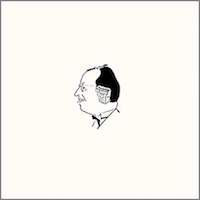
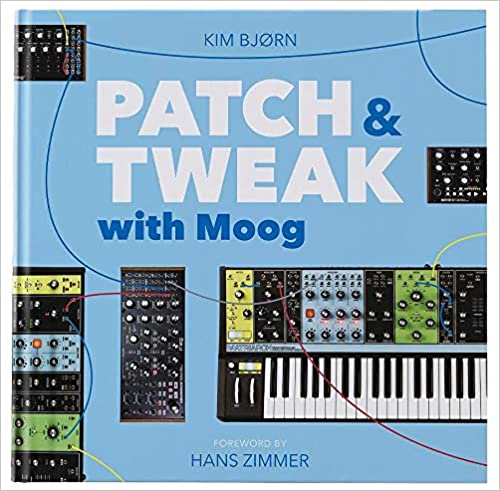







© Matrixsynth - All posts are presented here for informative, historical and educative purposes as applicable within fair use.
MATRIXSYNTH is supported by affiliate links that use cookies to track clickthroughs and sales. See the privacy policy for details.
MATRIXSYNTH - EVERYTHING SYNTH













© Matrixsynth - All posts are presented here for informative, historical and educative purposes as applicable within fair use.
MATRIXSYNTH is supported by affiliate links that use cookies to track clickthroughs and sales. See the privacy policy for details.
MATRIXSYNTH - EVERYTHING SYNTH





